Introduction
This is my 20-liter nano aquascape called: Little Wilderness
The name for this scape really says it all, I think. Personally, I just love a densely planted aquascape and I guess my style could be labeled as "jungle style". The idea for this aquascape was to really show that even in such a small aquarium you can still create something that’s quite interesting and has plenty of details.
For me what’s really important and what makes an aquascape interesting is when you keep discovering details, when fish and shrimp can get "lost" in the plant mass, and when you’re not sure of the actual size of the aquarium.
I think that’s how you attract the viewer and keep their attention.
Hardscape
Building this layout was not too difficult, I knew I wanted to go for a concave design, which basically means that you build up the sides with hardscape and plants, and leave an open space in the middle.
The lava rocks were placed leading from the front going towards the back, just to accentuate that middle point and open space.
Then it was just a matter of finding the right pieces of wood that fit together well. In total 5 pieces of spider wood were used.
When it comes to choosing rocks for a layout, I often go for black lava rocks. What I like about these rocks is that they have no effect on water parameters, the black color contrasts amazingly well with green plants, and they are very light weight which makes them a more affordable choice compared to other rocks.
For this layout I only needed 4 rocks, normally I would advise against using even numbers, but in this situation, I knew that the plants would cover most of the hardscape anyway.
Normal spider wood is usually a light brown color and will only get darker once it has been fully submerged for a longer period. The spider wood used in this layout is labeled as "black spider wood".
I think it’s a great combination with the lava rock.
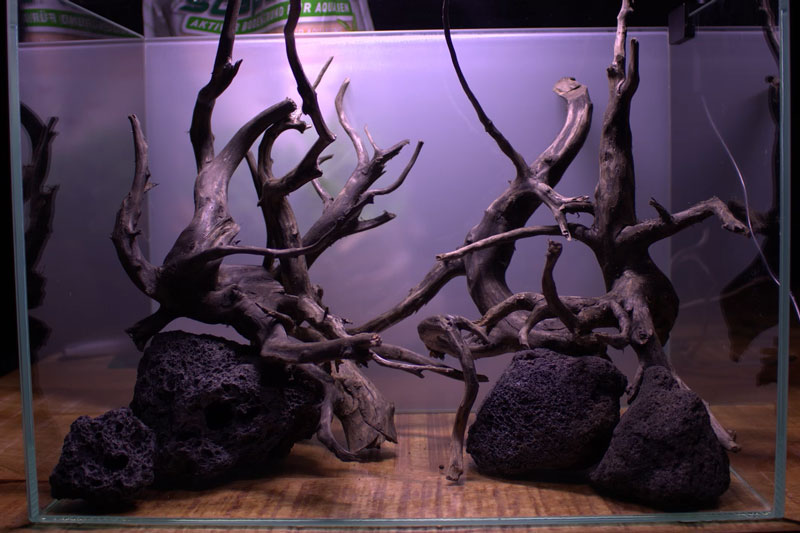
Substrate
Once the hardscape was done it was time to add the substrate. For this nano aquascape I used two types of substrate. The first base layer is a very nutrient rich layer that will provide a lot of nutrients for the plant roots. On top of that I used soil which is a complete substrate that lowers the ph and also provides nutrients to the plants.
It was actually my first time trying both of these products, and now after a few months I can say that I really like this combination, and I think the results speak for itself.
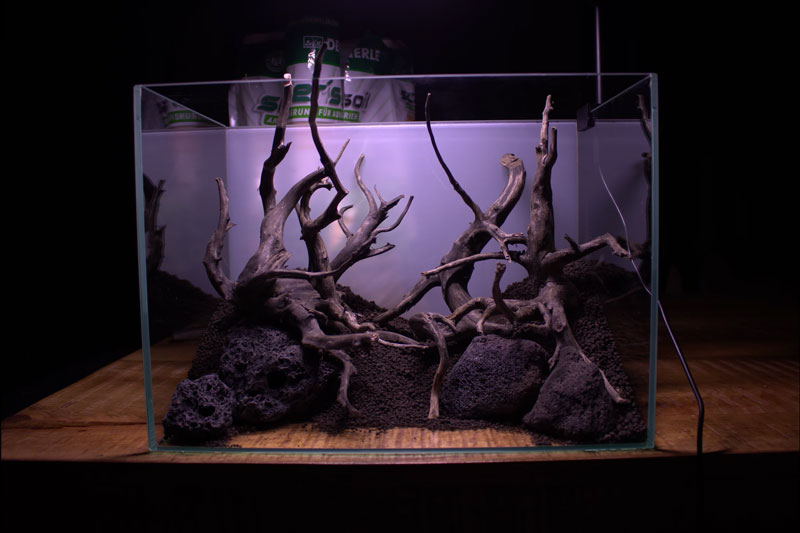
Securing the hardscape
Since this is a very small aquarium, I knew that maintenance, especially trimming the plants would be tricky and slightly difficult to maneuver without hitting the hardscape and potentially damaging the layout. To prevent this from happening I glued the rocks and wood together with a very simple technique.
I simply took little pieces of kitchen paper and wedged them into the points where the wood and rocks would connect. I would then drop a little bit of liquid cyanoacrylate superglue on the paper. After a few seconds the paper hardens and forms a strong connection with the hardscape.
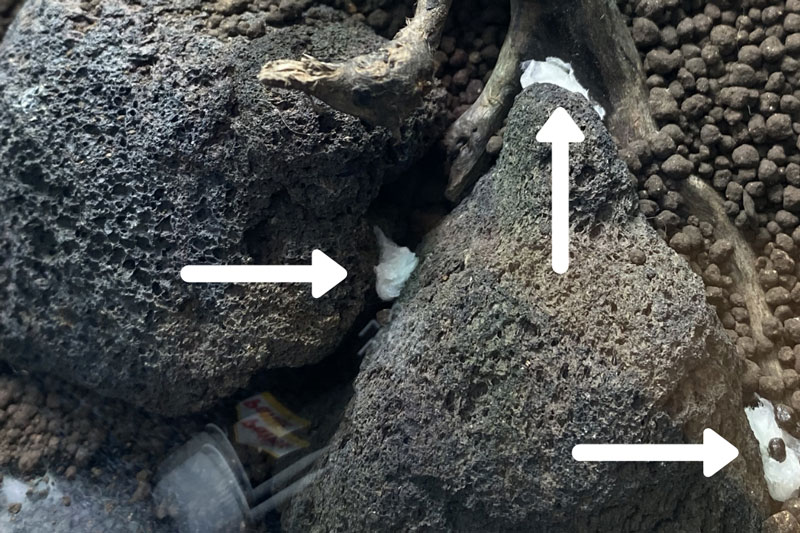
The last step is to "camouflage" these white pieces of kitchen paper, and for that I used soil that I crushed to powder. I would simply add a bit more superglue to the places that I want to cover op and sprinkle some of this powder on the glue.
Planting
Since this aquarium is only 20 liters, I wanted to use plants that stay relatively small. Choosing plants that grow too big will mess up the scale of the aquascape.
In the foreground I used primarily Hemianthus callitrichoides 'Cuba' this is one of the smallest textured foreground plants and with decent light and CO2 it's quite easy to grow. Now I'm a big fan of a ''mixed carpet'' so I also added some Marsilea hirsuta. This is an easy plant that contrasts nicely with the HC Cuba and will form a nice transition towards the midground.
Now this aquarium is only 22 cm deep, this makes it quite difficult to have a distinct midground, because there is just not a lot of space. Nonetheless I tried to make a transition with 3 plants: Cryptocoryne lutea 'Hobbit', Gratiola viscidula and Cryptocoryne pygmaea.
The background is planted with 2 types of very small stem plants, one of my favorites Hemianthus glomeratus and to add a little more texture Myriophyllum sp. 'Guayana'.
Lastly the epiphytes! On the wood and rocks I added my favorite moss of all time Riccardia chamedryfolia. It is commonly knows as corall moss and belongs to the group of liverworts.

Also, on the hardscape are several bucephalandra's these are slow growing plants from Borneo! I've added Bucephalandra sp. 'Serimbu Brown' and Bucephalandra sp. 'Lamandau Mini red'.
Technique
Even with these small scapes I prefer to use external filters. The extra biomass and filtration capacity just helps to stabilize the aquarium, and having less equipment in the aquarium is always a good thing.
With only 20 liters of volume, we don't want to sacrifice any of that for an internal filter, so I found the perfect filter for this little setup.

This filter is designed to be a so called ''HOB" - hang on the back filter, but since I didn't have space behind the tank, I've extended the hoses and placed the filter below the aquarium. The filter is rated at 360 liters per hour which may seem like a lot for a 20-liter tank, but with the lily pipe outflow I'd say it's perfect!
I used the filtration media that came supplied with the filter which is a mix of biological and mechanical media.
The light on this scape is an RGB led with a total of 54 led's and at the brightest setting it produces 1940 lumens! Way too bright of course for this little scape, but luckily it comes with a very handy dimmer. For the most part of this aquascapes lifetime the light was on for 8 hours at about 60% intensity.
In the area where I live the tap water quality is good, but the GH and KH are a bit high, so for this small scape I do like to make a little more effort and use Reverse Osmosis water. I have a small RO pump at home, and the 10L that I need for a weekly water change takes very little time to make.
CO2 and Fertilizers
On these small scapes I really like to use a very simple homemade CO2 system. One 1,5-liter soda bottle is partially filled with a sugar and gelatin mix, and topped with lukewarm water and yeast. The yeast will consume the sugar and create CO2 gas that will transport through some tubing and come out in the aquascape from a ceramic diffuser.
These systems are very simple to make, but do have some flaws. I recommend you to read about the pros and cons before trying it out yourself.
When it comes to fertilizing, I like to keep things quite simple. I find that having a lot of nutrients in the water column tends to lead to algae issues, so instead I rather have a very nutrient rich substrate. Besides that, I usually dose an "all in one" liquid fertilizer very sparingly, sometimes half the recommended dose, sometimes even less.
The Hemianthus glomeratus is a very good indicator plant. Whenever the tips go slightly pale or the growth is slowing down, I know I need to increase the fertilization a little bit.
The first 3 months…
are always the most difficult in a planted tank. I believe that's true for everybody, and when you acknowledge it the hobby becomes a lot more fun. Every aquascape that I make always goes through a couple "algae phases" and this is completely normal, most of the times the algae disappear by itself.
The first phase is always brown algae (diatoms) but I must say that in this scape it was very minimal, and I think that was because I’m using reverse osmosis water. A few clithon snails and otocinclus took care of the brown algae, and any leftovers were removed with general maintenance.
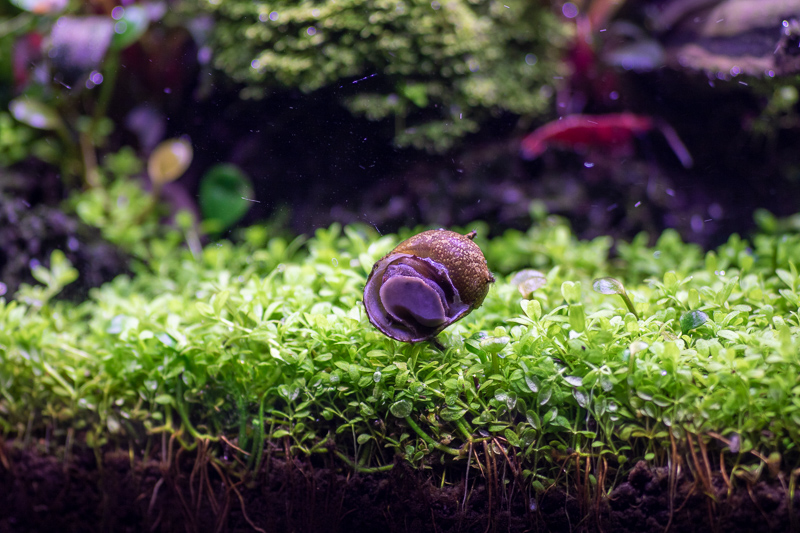
After the brown algae disappeared a new phase started with green spot algae again very minimal, but not very good looking. I believe that fresh soil is absorbing a lot of Po4 and the low levels of Po4 in the water column attract some green spot algae. The clithon snails eat some of it, but the majority is removed with maintenance using a brush or an old credit card.
As mentioned earlier I'm using a DIY CO2 system on this nano and one of the downsides of this system is that it can be a little bit unstable at times. So once in a while I would get a little bit of black beard algae on the hardscape or the bucephalandra's, but this is easy to correct by spot dosing some ''liquid carbon''
Besides that, I didn't have a lot of difficulties with this scape and I know that this was because I planted heavy from the beginning and used good quality healthy plants. By focusing on growing healthy plants algae will be kept to a minimum.
Inhabitants
A scape is not complete without some inhabitants and because we used almost exclusively green plants, I wanted a touch of red.
That's why I've added a group of red cherry shrimp. They look so good in between the green plants, like little red beetles crawling through the forest. They don't really eat algae in my opinion, but they are constantly grazing the surface of plants and hardscape eating the ''biofilm'' and with less biofilm there is less chance of algae growing on these surfaces.
Now I do prefer to keep some type of algae eaters in all of my tanks, just because it helps me with maintenance. So, I went with the smallest option: Clithon snails, these guys look great and eat most common algae.
For a short period of time, I also kept a few otocinclus in this nano as they are my favorite algae eaters, but for the long term I find these slightly too big for this size aquarium.
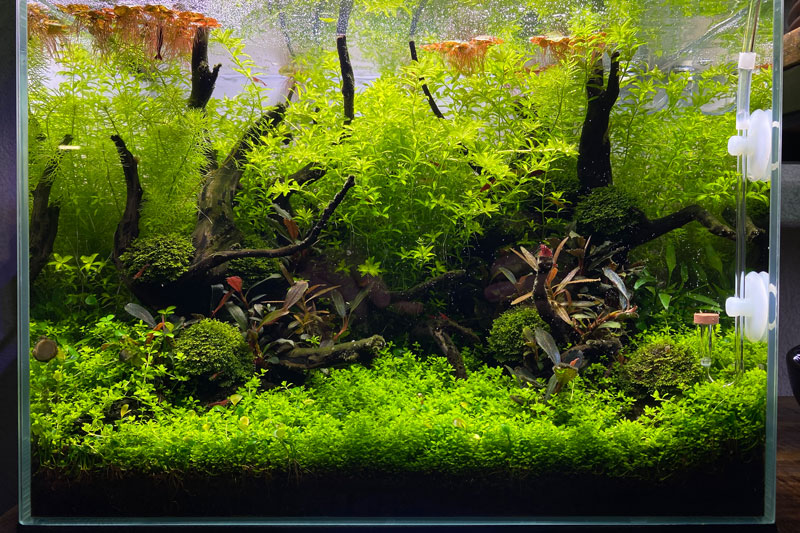
There are no other fish in the aquascape for a couple reasons:
First, I really enjoy just having the shrimp and the snails in here, fish are not necessarily a must for me, and because its only 20 liters it’s too small for most types of fish anyway. A small group of chili rasboras (Boraras brigittae) could have been an option, but I was unable to find them in my area.
I always maintain my scapes during the weekend, and this little scape takes very little time to clean. I do use reverse osmosis water for this tank, so I always make sure I have at least 10 liters of that prepared. General maintenance just means taking out 10% old water, cleaning the glass with an old toothbrush and an old credit card, then draining the rest of the water until 50% is taken out. I will then add the fresh RO water and add minerals to reach a tds of about 120.
This general maintenance session never really takes longer than 30 minutes.
Usually once a month I will do a more extensive cleaning which involves soaking the diffuser and filter inlet/outlet in some diluted bleach, as well as trimming the plants. I do have to say that trimming the plants in this small aquarium is quite a challenge! With the limited space, and the ''branchy'' hardscape it is not easy to maneuver a pair of scissors.
My favorite scissor for the job is the spring type scissor, they are very small and easy to handle.
Final words
I urge anyone who is thinking about having an aquarium to try out a nano tank of this size. You don’t need a lot of materials or a huge investment to get started. And it fits on any table, shelf or cabinet!
I’m really happy with how this little nano turned out. I often find myself losing track of time when sitting in front of it. While I’m finishing this article, this scape is just over 4 months old. I’m pretty sure it will stay with me for at least a year. Maybe I will make a few little adjustments in that time or try out some other plants, who knows. And maybe I will finally find a nice group of Boraras brigittae.
I hope you enjoyed reading this article, I certainly enjoyed writing it.
Best regards,
Mark
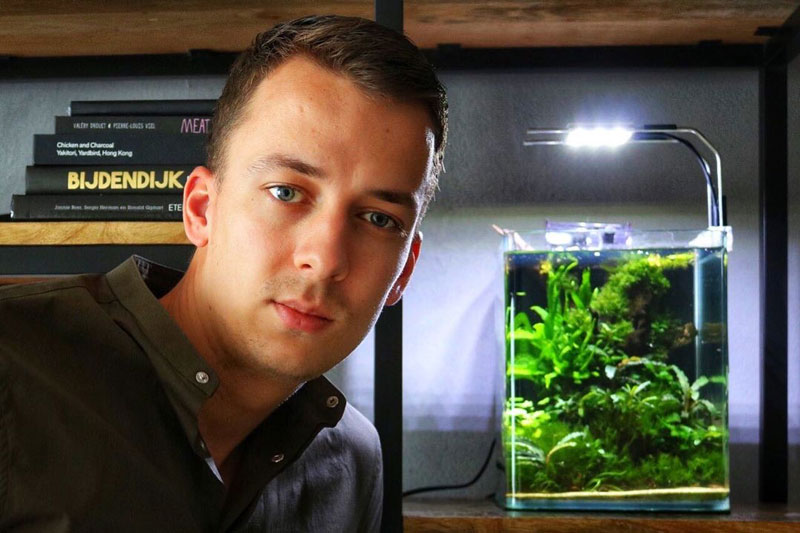
ps: find more work by MJ on his Facebook, Instagram and YouTube channel.
Details
|
Creator:
|
Mark-Jan Fioole
|
|
Title:
|
Little Wilderness
|
|
Aquarium:
|
36x22x26 optiwhite rimless aquarium
|
|
Volume:
|
20 liters
|
|
Light:
|
UNIQ Nano 18 watt (8 hours per day)
|
|
Substrate:
|
Substrate (1 liter) topped with soil (2 liters)
|
|
Hardscape:
|
Black lava rock, 4 small pieces roughly 1kg, Black spider wood, 4 pieces
|
|
Filter:
|
Hang on the back filter (360 l/h)
|
|
Filter media:
|
Bio-filter material and fine filter pad
|
|
Co2:
|
Homemade Bio CO2 (yeast and sugar) (30mg/l)
|
|
Fertilizer:
|
VIMI ALL IN ONE (1ml/day)
|
|
Maintenance:
|
Average 30 mins per week. Once a month 1 hour trimming session
|
Plants:
1x Cryptocoryne lutea 'Hobbit'
1x Marsilea hirsuta
1x Hygrophila Lancea Araguaia
1x Hemianthus callitrichoides 'Cuba'
1x Bucephalandra sp. 'Serimbu Brown'
1x Bucephalandra sp. 'Lamandau Mini red'
2x Gratiola viscidula
1x Riccardia chamedryfolia
1x Myriophyllum sp. 'Guayana'
3x Hemianthus glomeratus
Back to list